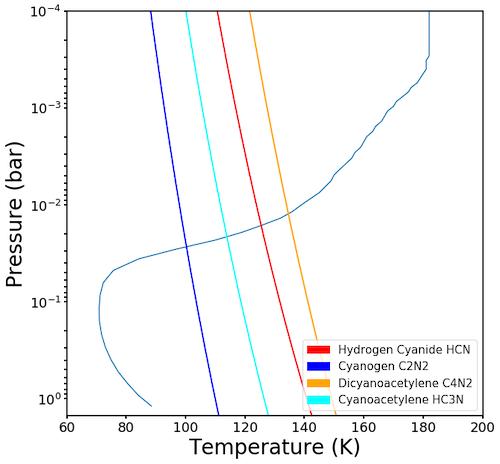Aerosol-Organic Condensates-Lake Interactions on Titan
- University of California Santa Cruz, Department of Earth and Planetary Sciences, Santa Cruz, United States of America (yxt2727@gmail.com)
Titan is a dynamic world with a unique N2-CH4 atmosphere where photochemistry is actively converting nitrogen and methane into organic hydrocarbon and nitrile molecules such as C2H6, C2H2, C3H8, C6H6, HCN, etc (Horst, 2017). These simple organic molecules could also further polymerize into more complex molecules and coagulate to form the refractory aerosols that make up Titan’s opaque haze layers. Observations from ground-based telescopes and spacecrafts have shown layers of clouds in Titan’s atmosphere and we have detected multiple hydrocarbon and nitrile compounds residing in the clouds, such as CH4, C2H6, C6H6, HCN, C4N2, HC3N (e.g., Anderson et al., 2018). The discovery of Titan’s clouds has made us wonder about their origin and formation and their role in Titan’s dynamics. The goal of this project is to provide a theoretical framework to better understand cloud formation on Titan through wetting and contact angle estimation. Many of the hydrocarbon and nitrile ice cloud species would remain solid when they fall onto Titan’s surface, so we also aim to study the interactions between these species and the surface of Titan’s lakes.
We first determined the species that are condensable in Titan’s atmosphere by plotting their condensation curves and the temperature profile of Titan. We found that CH4, C2H6, C2H2, C3H4, C3H6, C4H2, C6H6, C2N2, C4N2, HCN, and HC3N are able to condense into ice clouds and C3H8 are able to condense into liquid clouds. The refractory solid aerosols in Titan’s atmosphere are proposed to be cloud seeds for the observed cloud species. The surface energy of Titan’s aerosol analog “tholin” has been determined previously (Yu et al., 2017, in revision), which enabled us to estimate the liquid-solid/ice-solid contact angle between the potential cloud condenses and Titan’s aerosol. With the surface tension of the liquid cloud condensate (C3H8) and the surface energy of the solid cloud condensates (CH4, C2H6, C2H2, C3H4, C3H6, C4H2, C6H6, C2N2, C4N2, HCN), we found that the contact angle between all the organic condensates (solid CH4, C2H6, C2H2, C3H4, C3H6, C4H2, C6H6, C2N2, C4N2, HCN, and HC3N and liquid C3H8) and the aerosols are all relatively small (<35 degree). This indicates that Titan’s aerosols are easily wettable by the cloud condensates and are thus good cloud seeds for most simple hydrocarbon and nitrile clouds in Titan’s atmosphere. We also found small contact angles between solid organic species and the Titan lakes (a mixture of methane/ethane/nitrogen) before they fall into the lakes (assuming they are not soluble in the lakes), which means that these organic are likely unable to float on Titan’s lakes to damp the surface waves.

Figure 1: Condensation curve of the hydrocarbon species in Titan's atmosphere. The solid lines indicate gas-solid transitions and the dashed line indicates gas-liquid transition.

Figure 1: Condensation curve of the nitrile species in Titan's atmosphere. The solid lines indicate gas-solid transitions.
References:
1. Anderson, C. M., Samuelson, R. E., & Nna-Mvondo, D. 2018, SSRv, 214, 125
2. Hörst, S. M. 2017, JGR-Planets, 122, 432–482.
3. Yu, X., Hörst, S. M., He, C. et al., 2017 JGR-Planets, 122, 2610.
4. Yu, X., Hörst, S. M., He, C., et al. In revision
How to cite: Yu, Y., Garver, J., Yu, X., and Zhang, X.: Aerosol-Organic Condensates-Lake Interactions on Titan, Europlanet Science Congress 2020, online, 21 September–9 Oct 2020, EPSC2020-1013, https://doi.org/10.5194/epsc2020-1013, 2020

